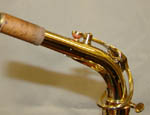A common problem that occurs on saxophones, especially in the hands of young students, is the octave key on the neck goes out of adjustment. A good indication that this has happened is when the notes below high A (first ledger line above the staff) won’t play. Several things can cause the octave key to go out:
- Too much in the corner pocket of the case where the neck often gets tossed. Forcing the neck into the cramped space can bend the octave key.
- The neck gets bent down, changing the relationship between the neck and octave key. In this case, the horn should be taken to the repair shop for the neck to be repaired but following these instructions may get you through a concert or rehearsal until that can happen.
How the Neck Octave Key Should Function

Finger high G (just above the staff). The neck octave key should remain closed. Lift the left hand fourth finger to play A and the neck octave key should open.
If the octave key is not behaving properly, it is usually because of one of two scenarios:

Octave Key Doesn’t Close for G
To remedy this problem do the following with the saxophone in playing position:
- Gently push down on the upper part of the octave key (the part with the pad) while pulling the bottom part of the octave key (the part that connects with the key on the body) toward you.
- Check by observing the octave key while fingering high G and A as above.
- Repeat as necessary or alternate with instructions for “Octave key doesn’t open on A” (below) until octave key opens the desired distance.

Octave Key Doesn’t Open on A
To remedy this problem do the following with the saxophone in playing position:
- While holding the upper portion of the octave key open, gently push the lower portion down and away from you.
- Check your work. If the octave key now opens on A, be sure to check that it still closes for G.
Please note that the octave system (upper and lower) on a saxophone is a complex series of mechanisms. Adjusting the octave key in the method described above may get the horn playing but complete regulation often involves additional steps such as removing lost motion, adjusting key corks, adjusting spring tensions, etc. See your local repair technician for additional regulation adjustments.



